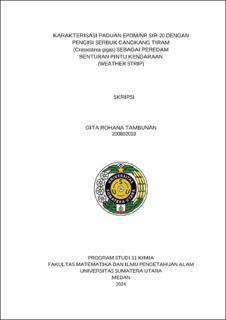| dc.description.abstract | Research on composites from the EPDM/NR SIR-20 alloy with the addition of oyster shell powder (Crassostrea gigas) as a filler material which is applied as a vehicle door impact absorber (weather strip). Making weather strips is done by mixing SIR-20 natural rubber with vulcanized EPDM synthetic rubber by adding stearic acid, ZnO, MBTS, sulfur and varying oyster shell powder filler with a particle size ratio of 50 mesh; 100 mesh; 150 mesh; 200 mesh, 30 grams each. Then it is pressed using a hot press at a temperature of 125°C to produce a composite which is then subjected to tensile and impact tests. From the tensile strength test results, the best variation was obtained in oyster shell powder filler using the Test Sieve-Sifter Mesh 200 with a particle size of 75 μm, namely with a tensile strength value of 2.3270 Mpa with an Elongation at break of 912,26% and an elastic modulus of 0.25 MPa. The best impact test was the Sieve-Sieve Mesh 200 Test variation with a particle size of 75 μm, namely with an impact strength value of 10646.73 J/m2. EPDM/NR SIR-20 specimens with optimum filler were subjected to FTIR and SEM analysis testing. The results of the FTIR analysis showed no significant changes between EPDM, NR SIR-20 and composites with optimum fillers, there was only a shift in wave numbers in several new absorption functional groups found in the composite sample with the addition of oyster shell powder optimum at wave number 1088 cm-1 C-O stretching is stearic acid and at wave number 875 cm-1 stretching is the Ca-O group from oyster shells, also at wave number 693 cm-1 C-S bending is a disulfide bond this indicates that vulcanization by sulfur has occurred on EPDM synthetic rubber to form vulcanized rubber. The SEM results obtained showed that there were still air cavities, caused by some oyster shell powder not perfectly evenly filling the empty space of the rubber. | en_US |


